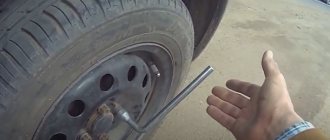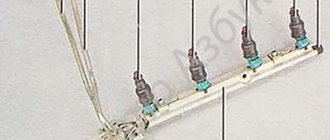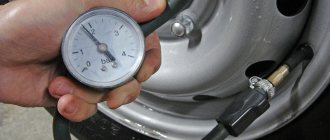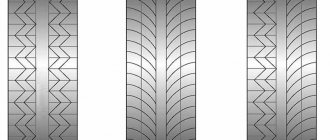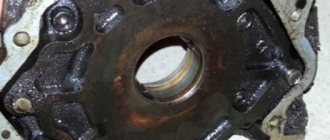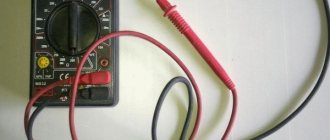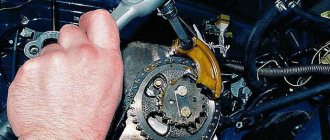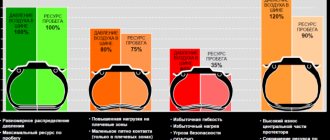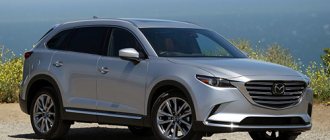Why measure tire pressure on Niva Chevrolet
Before you start measuring tire pressure, you need to decide on the units of pressure measurement. The most common are bar and atmosphere (atm.). Many people consider them identical, but this is not entirely true. If we take one normal atmosphere (760 mm Hg) as 1, then 1 bar will be 1.0133 atm. The difference of less than 2% is caused by the peculiarity of the mmHg conversion. Art. to Pascals in the SI system. All modern pressure gauges are marked in bars or atmospheres.
Timely monitoring of tire pressure affects:
- stability of straight motion;
- maximum braking distance of a car;
- stability and safety of control in extreme conditions;
- uniform tire tread wear;
- eliminates damage to tire sidewalls and cords;
- reduces fuel consumption at all speeds.
The pressure in Niva Chevrolet tires may be too low or too high . The behavior of the car on the road differs from this value as follows.
Important! The nominal level for wheels with landing radius R15, R16 is taken to be the factory setting of 1.9 bar.
Blood pressure is higher than normal . The car's ride becomes harsher, the contact patch with the road surface decreases, and directional stability deteriorates. The braking distance increases greatly, especially on wet or slippery surfaces. Characteristic bald spots appear on the tread in the middle of the wheel. An overinflated wheel is much easier to damage, and strong impacts are transmitted to the disc and suspension elements.
Underinflated wheels increase the effort on the steering wheel of the car and significantly increase gas mileage. The behavior of the SUV on hard surfaces becomes slack, the car yaws and floats on the road at high speed. The tread wears out from the edges of the tire, and the sidewall becomes cracked. Such a wheel cannot protect the disc from a strong impact when falling into a hole.
Advice. If the pressure on all wheels is not uniform, the car will pull towards the flat tire.
The causes of flat tires are universal for all brands of cars - punctures, damage to the beads, curvature of the wheel rim, air leakage through the valve, drying out and loss of tightness of tires due to age.
Interesting video about the effect of tire pressure on cross-country ability:
You can reduce fuel consumption and reduce tire wear, which will lead to unnecessary expenses on new ones, by setting the correct tire pressure. Therefore, constant monitoring of tire pressure will save you from these negative consequences, but will also ensure safe driving on the roads. Below is a table indicating what pressure should be:
The best way to help you in this matter is the manual that comes with your purchase. We recommend that before long trips, and also once every two weeks, you check the tire pressure in the Chevrolet Niva, as well as in the spare tire itself; if the level is low, then the wheel should be inflated; this can be done either yourself or at a specialized tire shop.
Instruments and methods for measuring pressure
Chevy Niva tire pressure measurements are carried out with any mechanical or electronic pressure gauge:
- Mechanical dial pressure gauges are considered simple and unpretentious devices. The operating principle is based on a cylinder with a piston and a spring, and an arrow associated with it. Measuring range from 0.1 bar to 8 bar. The disadvantage of pointer instruments is the low measurement accuracy and dependence on the ambient temperature (underestimates readings in winter). Pros: reliable and cheap, do not require a power source.
- Electronic or digital pressure gauges . Modern high-precision instruments. Models from well-known manufacturers have minimal errors. Equally accurate in winter and summer. Cons: high price, less reliability.
Important! Measurements are made with a stationary vehicle and cold tires. After driving, you should let the car sit for 2-3 hours in summer or up to half an hour in winter. The correct order of measurements is indicated in the instructions for the pressure gauge.
The disk-tire system is not completely sealed, especially on off-road vehicles , which include the Chevrolet Niva. Air under pressure will always find a place to escape, so such pressure checks should become regular, and not 1-2 times a year when changing tires. The optimal mode is to check once every 2-3 weeks, before a long trip and after off-road trips.
Advice. Many drivers forget about the condition of the spare tire and only remember it when changing it. A deflated spare wheel will not help if a tire punctures, and you will only be able to drive a deflated wheel for a few kilometers, after which the tire will most likely have to be thrown away.
Correct pressure in a Chevrolet Cruze
Cruze cars may have tires of size 15, 16, or 17. The optimal pressure should be 2.2 bar. These parameters apply to both the front and rear axle wheels. The table on the car body indicates that the minimum fuel consumption is achieved at 2.7 Bar. On the one hand, this is good, but on the other hand, there will be an increased load on the suspension and the middle part of the tread, which will wear out intensively.
On a note.
These parameters are suitable for fast movement on the highway, but for ordinary city roads it is better to stick to 2.2 bar. Therefore, it is not worth maintaining high blood pressure unnecessarily for a long time. This may still be justified when the machine is heavily loaded. Then increasing the number of atmospheres is simply necessary, since the tires are under heavy load.
Off-road wheels on Chevy Niva
The difference between special off-road tires and all-season tires lies in a different power structure and standard size. Among the manufacturers of mud tires for Chevrolet Niva, BFGoodrich, Cordiant, Forvard, Federal Mogul and others have proven themselves well. They produce tires in sizes 215/65/R15, 215/75/R15, 225/65/R15, which fit on the Niva with minimal modifications to the standard wheel arches. Tread type M/T or A/T.
Off-road tires are distinguished by increased lugs and a reinforced tire sidewall . In addition, it is elastic and works well when deflated to a minimum. The working pressure of mud tires directly depends on the type of terrain being overcome. On rocky soils it is recommended to pump up to 2.3-2.5 atmospheres. This increases the ground clearance and traction properties of the tires. On muddy ground, sand or snow, the pressure is released to 0.8-1 bar. The tires roll well and allow you to overcome very difficult areas.
Methods and frequency of measuring air pressure in Chevrolet Niva tires
Tire pressure is measured using special devices and at specified intervals. The main measuring device is a pressure gauge. There are two categories of this device:
- mechanical;
- electronic.
The first ones are distinguished by the fact that they have a mechanical drive in combination with a dial indicator. The disadvantage is the rather high level of error, which increases in the cold season. This is due to temperature deformation. In connection with this, mechanical pressure gauges are used in the cold only as an aid until the opportunity to visit a service station arises. But this disadvantage is offset by the long service life and the absence of the need for a power source.
The second category of devices is powered by a battery that is charged through a network connection. The main drawback is the ability of the battery to die at the most inopportune moment. Thanks to a more complex device, such a pressure gauge has minimal error. The data is displayed on a screen similar to the display of other electronic devices.
Checking tire pressure before each long trip is a mandatory step to ensure the safe operation of the vehicle. Do the necessary actions in a certain sequence:
- let the car sit for at least three hours;
- check that the tires are cold;
- connect the pressure gauge and take measurements as indicated in the instructions for it;
- check the result with the table of acceptable values;
- recheck the data after a half-hour pause.
Evidence of a puncture will be a decrease in readings between two measurements. The absence of any changes indicates that the situation is normal.
Experts recommend checking the pressure after driving. This must be done two and a half or three hours after stopping. Thanks to this additional measurement, you can eliminate the possibility of a puncture formed during the trip. It is necessary to measure data not only on the installed tires, but also on the one that is used as a spare.
Niva Chevrolet and low pressure wheels
Low-pressure tires or arched tires are highly specialized tires that are designed primarily for constant use in severe off-road conditions, in swampy areas, and deep snow. They differ from ordinary off-road wheels in their width, light weight, and the normal pressure in such wheels is 0.5-0.7 bar.
It is impossible to install low-pressure tires on a standard Chevrolet Niva without modifying the car . You will need to lift the car and suspension, change the main pairs, strengthen the suspension elements, and install a pumping system. Such tuning turns the Niva into an excellent rogue on any terrain.
Disadvantages of low pressure tires in everyday use:
- short wheel life;
- reduction of maximum speed;
- deterioration in controllability;
- decreased reliability of the vehicle transmission;
- transfer of the car to the section of self-propelled vehicles;
- increased gasoline consumption.
Hoses for power steering Niva Chevrolet, life
set of 3 hoses
The power steering system consists of 4 hoses. One high pressure with a valve in the middle (pump-steering machine) and 3 low pressure hoses. In the designer's fields, the radiator was completely excluded from the system, so there are only two low-pressure hoses. The pressure in the “main” hose reaches several tens of kg, but there is almost no pressure in the “secondary” hoses.
The plant, with the tenacity of maniacs, installs rough, thick-walled high-pressure hoses. Their disadvantage is that they cannot normally be compressed even with threaded clamps, especially in cold conditions. So their wet appearance is normal. The recommendation is simple, along with replacing the fluid and flushing the system - replace the Chevrolet Niva power steering hoses with modern and high-quality ones.
Since I don’t really like stepping on rakes, I consulted with a hydraulic engineer on this topic. He “gave me” a Taiwanese hose manufacturer. The working pressure of the hoses is 250PSI (approximately 17 atmospheres). For general technical development, let me remind you that PSI is pounds per square inch. The hoses are two-layer.
The internal part is MBS (oil and petrol resistant), the external part maintains external temperatures. Based on many years of installation experience on different machines, I can say the following. No cracks have ever been noticed in any climate. The most I have noticed is fading after a couple of years of use in hot climates, but as you know, this does not affect the speed.
Read news about the new Niva
- FROST car air conditioners // Online store // Prices // Air conditioners for cars Lada VAZ, VolksWagen Polo, Daewoo Matiz
- Low engine oil pressure causes and solutions
- No longer Chevrolet: Lada Niva returns - Autoreview
- Lada 4×4 Bronto - sales stopped, new details » Lada.Online - all the most interesting and useful about LADA cars
- Description of the instrument panel Lada 4×4 (VAZ 2121, 2131) » Lada.Online - all the most interesting and useful about LADA cars
- What will the new Niva 2024 be like, new details » Lada.Online - all the most interesting and useful about LADA cars
- Buy Chevrolet Niva 2019-2021, models, price | Vita-Auto, Moscow
- LADA Niva – Operating manual – Official LADA website
Consequences of incorrect tire pressure
Most car owners should remember the manufacturer's recommended tire pressure value for Chevrolet Niva - 1.9 bar . This is a normal value that should be used as a starting point when making adjustments up or down. Minor deviations will not lead to adverse consequences. There may be an increase in fuel consumption or slight discomfort in the car interior.
But deviations from the norm of 0.5 atmospheres or more already have a serious impact on safety and controllability and cause increased tire wear. To avoid this, it is recommended to always have a high-quality pressure gauge in your car and regularly measure the pressure in all wheels, including the spare tire.
Comments
Guests cannot leave comments on the site, please log in.
Products for LADA at the best price
A selection of accessories for LADA from AliExpress
- Why is it worth regularly checking the tire pressure in your Chevrolet Niva and how does it affect safety?
The importance of maintaining the correct pressure in Chevrolet Niva tires is one of the most underestimated parameters by car owners. This is important because the pressure maintains a range of performance characteristics:
- car control stability;
- ride stability;
- braking distance within the design;
- specified trajectory of movement;
- uniform wear of the treadmill, due to which the service life of the tires is maintained at the proper level;
- integrity of the side surfaces;
- volumes of fuel consumption not higher than those specified in production.
The Niva manufacturer recommends that the pressure on both the front and rear axles reach 1.9 bar. The recommendation applies to the sizes of 15-inch tubeless tires 205/70, 205/75 and 16-inch 215/65.
In the case of off-road driving, factory recommendations allow the indicator to be reduced to one and a half bar. In some cases, car owners themselves increase the pressure to 2 or 2.2 bar for driving on the highway. The manufacturer indicates that pressure above two makes the ride harsher and less comfortable.
Measuring methods
It is impossible to determine the amount of air in tires without special instruments. Outwardly, it turns out to notice only some deformations, the cause of which was incorrect pressure. As a result, some depression may appear on the rubber itself and the tread pattern may change.
You can measure tire pressure on a Chevrolet Niva only using pressure gauges. There are two types of such devices:
- mechanical (switch);
- electronic.
Electronic pressure gauge for cars
The percentage of error for mechanical pressure gauges is higher, but not significant. In everyday life, they can be used with the same success as their electronic counterparts. Electric pressure gauges provide the most accurate results. The error indicator in this case is no more than 0.05 bar. Today this is the most accurate device for measuring tire pressure not only on Niva, but also on other cars.
It should also be noted that in winter the tire pressure level can be more or less accurately measured only with an electronic pressure gauge.
Relieving pressure correctly
In order for the readings to be accurate, you need to remove the pressure correctly. This should be done this way:
- tires must be unheated;
- for the last 3 hours before measurement, the car should be at rest or drive no more than 1.5 kilometers;
- Measurements must be taken on all four wheels and the spare wheel.
Only in this case can the readings from the pressure gauge be considered correct.
Table of values for the required tire pressure level for the Chevrolet Niva:
| Automobile model | Years of production | Tire size | Front tire pressure (atm./psi) | Rear tire pressure (atm./psi) |
| Chevrolet Niva | 2004—2014 | 205/75 R15 | 2,1/30 | 2,1/30 |
| Chevrolet Niva | 2004—2014 | 205/70 R15 | 2,1/30 | 2,1/30 |
| Chevrolet Niva | 2004—2014 | 215/65 R16 | 2,2/31 | 2,2/31 |
The pressure standards for Niva wheels 2121 or 21214 must be indicated on a special metal plate. As a rule, it is attached to the door on the driver's seat side. If for some reason there is none, you can look at the data online. But in this case, it is better to take into account the readings only approximately.
You should also pay attention to the fact that the amount of air in the rear tires should be about 0.3-0.5 bar more. This is due to the fact that the load on the rear axle of the wheel is always greater than on the front.
